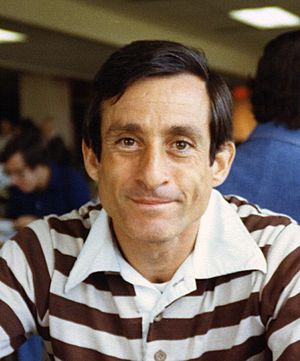Peter Goldreich facts for kids
Quick facts for kids
Peter Goldreich
|
|
|---|---|

Peter Goldreich in 1980
|
|
| Born | July 14, 1939 |
| Alma mater | Cornell University |
| Known for |
|
| Awards | Chapman Medal of the Royal Astronomical Society (1985) Brouwer Award (1986) |
| Scientific career | |
| Fields | Astronomy and Astrophysics |
| Institutions | Caltech Institute for Advanced Study |
| Doctoral advisor | Thomas Gold |
| Doctoral students |
|
Peter Goldreich (born July 14, 1939) is a famous American astrophysicist. He studies how things move in space, like planets and their moons. His research also looks at planetary rings, how the Sun vibrates (called helioseismology), and tiny, super-dense stars called neutron stars.
He is a professor at the California Institute of Technology (Caltech). Since 2005, he has also taught at the Institute for Advanced Study in Princeton, New Jersey. An asteroid in space, 3805 Goldreich, is named after him!
Contents
Peter Goldreich's Journey in Science
Peter Goldreich started his science journey at Cornell University. He earned his first degree in engineering physics in 1960. Then, he got his PhD from Cornell in 1963. His teacher was a scientist named Thomas Gold.
After his studies, Goldreich worked as a researcher at Cambridge University for a year. From 1964 to 1966, he taught astronomy and geophysics at UCLA. In 1966, he joined the faculty at Caltech. He became a full professor there in 1969. He is now the Lee A. DuBridge Professor of Astrophysics & Planetary Physics at Caltech.
Amazing Discoveries and Ideas
Peter Goldreich has made many important discoveries in space science. He often works with other scientists to figure out how the universe works.
Understanding Moons and Orbits
In 1966, Goldreich wrote an important paper about how the Moon's orbit changed over time. He also studied the orbits of other moons in our Solar System. He found that moons close to a planet stay tilted in a certain way compared to the planet's equator. Moons farther away stay tilted compared to the ecliptic, which is the path the Sun seems to take across the sky.
He noticed that most moons close to their planets orbit near the planet's equator. This suggests they formed from a flat disk of material around the planet. However, he found that Earth's Moon, even though it was once closer, never had an orbit near Earth's equator. This is known as the "lunar inclination problem," and scientists are still working on solutions.
Planetary Changes and Rings
In 1969, Goldreich and Alar Toomre described something called polar wander. This is when a planet's poles (like the North and South Poles) can shift over time. Later, evidence from ancient magnetism proved this idea.
Goldreich also worked with George Abell. They figured out that planetary nebulae come from red giant stars. This idea is now widely accepted by scientists.
In 1979, Goldreich and Scott Tremaine made a big prediction about Saturn's F ring. They said that tiny "shepherd moons" must be keeping the ring in place. This was proven true by observations in 1980! They also predicted that Uranus' rings were held by similar moons, which was confirmed in 1986. Goldreich and Tremaine also predicted "planetary migration" in 1980. This idea helps explain how planets like "hot jupiters" (giant planets orbiting very close to their stars) got to where they are.
Pulsars and Black Holes
In 1969, Goldreich and William Julian published a classic paper about pulsars. Pulsars are rapidly spinning neutron stars that send out beams of radiation. They created a simple model to show how the magnetic fields of these stars work. They explained how these fields can take energy from the spinning star to create the radiation we see. Scientists later used similar ideas to understand the magnetic fields around spinning black holes.
Awards and Special Recognition
Peter Goldreich has received many awards for his important work. These awards show how much his contributions have helped us understand the universe.
- National Academy of Sciences, elected 1972
- American Academy of Arts and Sciences, elected 1973
- Henry Norris Russell Lectureship of the American Astronomical Society, 1979
- California Scientist of the Year, 1981
- Chapman Medal of the Royal Astronomical Society, 1985
- Brouwer Award of the Division on Dynamical Astronomy of the American Astronomical Society, 1986
- Gerard P. Kuiper Prize of the Division for Planetary Science, American Astronomical Society, 1992
- Gold Medal of the Royal Astronomical Society, 1993
- National Medal of Science, 1995
- Foreign Member of the Royal Society, 2004
- Grande Médaille of the French Academy of Sciences, 2006
- Shaw Prize, 2007
In 1995, he received the National Medal of Science. This award recognized his "profound and lasting contributions to planetary sciences and astrophysics." It honored his ideas about how planets rotate, how planetary rings work, pulsars, and even how the Sun vibrates.
In 2007, he received the Shaw Prize in Astronomy. This was for his amazing work throughout his life in theoretical astrophysics and planetary sciences.

